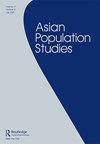重新审视孟加拉国生育率下降的原因:女性教育和计划生育方案的相对重要性
IF 1.5
4区 社会学
Q2 DEMOGRAPHY
引用次数: 6
摘要
摘要孟加拉国是世界上最贫穷的国家之一,自1985年以来,其生育率急剧下降,总生育率从5.5-2.1下降。国际研究人员对这种快速下降的原因进行了辩论,一些研究将其主要归因于计划生育计划,另一些研究则指出,妇女教育和其他社会经济因素同时增加。利用七轮孟加拉国人口健康调查(BDHS)的数据,我们通过重建受教育程度的队列和时期生育率指标,全面审查了生育率趋势。多水平回归显示,在个人和社区层面,生育率与受教育程度之间存在显著的负相关。Pathway的分析表明,女性教育对生育欲望下降有显著影响,而其他影响则占主导地位。妇女受教育程度的提高以及预期家庭规模的缩小可能是孟加拉国生育率大幅下降的主要因素。本文章由计算机程序翻译,如有差异,请以英文原文为准。
Revisiting the causes of fertility decline in Bangladesh: the relative importance of female education and family planning programs
ABSTRACT Bangladesh, one of the world’s poorest countries, has experienced a dramatic decline in fertility since 1985, with a decline in the total fertility rate from 5.5–2.1. International researchers have debated the reasons for this rapid decline, with some studies attributing it primarily to family planning programmes and others pointing at the simultaneous increase in the education of women and other socioeconomic factors. Using data from seven-rounds of the Bangladesh Demographic Health Survey (BDHS), we comprehensively review fertility trends by reconstructing cohort and period fertility indicators by educational attainment. Multilevel regression shows a robust negative association between fertility and educational attainment at the individual and community levels. Pathway’s analysis reveals that female education has a significant effect on declining fertility desires dominating all other effects. Increased women's education and the associated diffusion of smaller desired family size might be the primary factor driving the impressive fertility decline in Bangladesh.
求助全文
通过发布文献求助,成功后即可免费获取论文全文。
去求助
来源期刊

Asian Population Studies
DEMOGRAPHY-
CiteScore
3.30
自引率
14.30%
发文量
12
期刊介绍:
The first international population journal to focus exclusively on population issues in Asia, Asian Population Studies publishes original research on matters related to population in this large, complex and rapidly changing region, and welcomes substantive empirical analyses, theoretical works, applied research, and contributions to methodology.
 求助内容:
求助内容: 应助结果提醒方式:
应助结果提醒方式:


